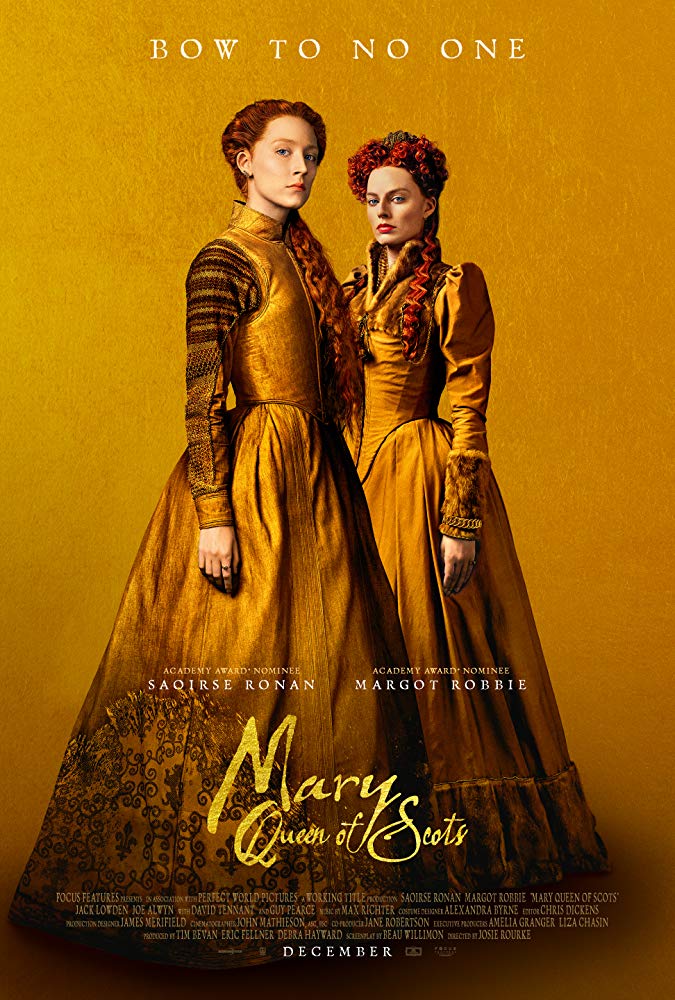There is no doubt about it; Josie Rourke’s new adaptation of one of the 16th century’s most intriguing plots is beautifully shot. Unfortunately, John Mathieson’s cinematography remains one of the few memorable and striking elements of the new Mary Queen of Scots (2019). Exploring the relationship between Elizabeth I and her younger cousin, Mary Queen of Scots, the film follows John Guy’s novel Queen of Scots: The True Life of Mary Stuart which sought to revamp the traditional tale of Elizabeth’s ruthless decision to end Mary’s life. The two rulers, both fairly young when the story begins, are joined by blood and separated by religion. Elizabeth, daughter of Henry VIII, is Protestant while her cousin Mary, once married to the King of France, is Catholic.
Tweaking the historical narrative to a questionable extent, Rourke’s adaption aims to place the onus of Mary’s fateful ending on the men that surrounded them, manipulating both women into precarious positions for their own gain. Unfortunately this perspective along with the lacklustre narrative has the reverse effect in highlighting the power of both female figures, eventually falling flat due to the slow pace and lack of tension or build up.
This is most visibly seen in Margot Robbie’s portrayal of the ruthless Elizabeth I, giving a newfound vulnerability to the Queen compared to past performances from Cate Blanchett and Judy Dench. This seemed to be an odd directorial decision, Robbie delivering her lines in a timid voice and having little authoritative presence onscreen in her interactions with the Privy Council and her Court. It seemed unusual to picture this monarch more commonly renowned for her authoritative rule and magnificent defeat of the Armada, reduced to an insecure and blushing maiden. Hiding her appearance behind a veil throughout a severe bout of chicken pox, Robbie succeeded in adding a sense of fragility to the role that has rarely been explored in previous filmic adaptations of the Queen. It’s this fragility that seemed strained and overdone throughout the film, culminating in a scene where shortly after sanctioning Mary’s execution warrant, Elizabeth breaks down in tears amongst a snowy backdrop. Whilst this scene was exquisitely shot with the harsh, theatrical colours of Elizabeth’s costume and makeup against the quiet snowfall, her empathy towards Mary and the Catholic plot to overthrow her is indeed questionable and perhaps uncalled for. There are other methods of exploring the multidimensionality of an iconic female figure than simply showing them to be more emotional and compassionate than the history books perceive them to be.
Perhaps this decision was to enhance Saoirse Ronan’s undeniably powerful performance, which was a world away from the spunky teen she played last year in Ladybird (2018), which lead to her ‘Best Actress’ Oscar nomination. Beau Willimon’s wry script poses Mary as a vibrant and tactful leader, intent on determining her own path and outsmarting her opponents. Ronan effortlessly captures a balance between a fearless ruler and a girl very much on the brink of womanhood, best shown in the scenes with her maidservants, which are filled with youthful laughter and a sense of comfort amongst the religious turmoil. Ronan proves her increasing capability as an actor, possessing a steely and warrior-like persona striding ashore and marching towards Holyrood.
[embedyt] https://www.youtube.com/watch?v=wnqjSgMU36U[/embedyt]
She undoubtedly shines as the titular figure and her strength never wanes, even in her final scene where she arrives dressed in a striking bright red gown to wear for her execution. Elizabeth uttering the words ‘she thinks herself a martyr’ upon the unveiling of the gown allows for a spectacular finishing scene, with the steely red standing out amongst the drab grey of the execution chamber. It’s therefore easy to see why costume designer Alexander Byrne has been nominated for an Oscar in the upcoming 91st Academy Awards. The costume and makeup are redeeming factors in the film, consistently acting as a protective force against the patriarchal surroundings for both Queens; Mary is usually dressed in armour or tightly corseted dresses and Elizabeth is almost camouflaged in thick layers of theatrical makeup and lavish clothing.
The film seemed to be building up to a meeting scene between the two monarchs at a secluded house in the woodland which, when it eventually arrived, was somewhat disappointing. All of a sudden an array of visual symbolism was introduced, something that I thought the film had decided to mainly overlook and to centre on the performances instead. This was seen in the abundance of white flowing pieces of cloth hanging up inside the room in Mary and Elizabeth’s first encounter, obscuring their appearances until they finally talked to one other face to face. This was meant to perhaps show the duality between the two but instead ended up looking as if someone had left the window open after hanging their washing out to dry. The scene is well acted and perhaps the best scene to showcase Robbie’s acting, yet she still whispers that she has ‘relinquished all sense of self to the throne’. It’s this malleability and complete lack of strength that is heavily overdone throughout the film, ultimately proving a disservice to a powerful female monarch simply to enhance the commonly overlooked figure of Mary Queen of Scots. In this day and age, I think there needs to be less trepidation in portraying two angry, powerful and self-assured women and facing them against one another.
Image source: IMDB


[…] Click here to read the original article published on The Badger […]